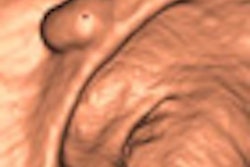A new study is advising orthopedic physicians to take greater care when imaging patient extremities with both standard and mini C-arms, because the risk of radiation exposure in previous studies has been underestimated.
Researchers in the department of orthopedics and rehabilitation at the University of Rochester Medical Center (URMC) in Rochester, NY, assert that previous research on radiation exposure was conducted under best-case scenarios and, subsequently, the data may be misleading.
"[Prior research] shows zero radiation exposure outside the path of the beam [and] minimal exposure to the patient in the path of the beam,'' said Dr. Brian Giordano, lead author and chief orthopedic resident at URMC. "We have looked at some of that data and the misconceptions and tried to place them in a more realistic context."
Extremity placement
The study, published in the March 2009 issue of the Journal of Bone and Joint Surgery (Vol. 91, pp. 297-304), also noted that the amount of radiation exposure to patients and surgeons depends on tissue density and the shape of the imaged extremity. Elevated exposure levels can be expected when larger body parts are imaged or when the extremity is positioned closer to the x-ray source.
"Just placing the extremity on the image intensifier versus bringing it closer to the radiation source can change by a factor of 10 the amount of radiation the patient receives," Giordano said.
The researchers took a cadaver ankle and suspended it on an adjustable platform to shift the extremity's distance closer to the radiation source or closer to the C-arm's image intensifier. They also peripherally positioned 13 film-badge dosimeters around the specimen at different angles to gauge the amount of radiation a patient might receive. The data were collected over an imaging time of five minutes.
The researchers tested both the standard C-arm and mini C-arm under three different configurations:
- A best-case scenario, with the cadaver ankle almost in contact with the image intensifier
- A midway position, with the specimen 10 inches from both the image intensifier and radiation source
- A worst-case scenario, where the specimen was placed within 2 inches of the radiation source
Exposure levels
In the worst-case configuration, radiation exposure measured 8,988 microrems (mrem), or 89.9 milliseverts (mSv), with the standard C-arm, compared with 3,912 mrem (39.1 mSv) for the mini C-arm. Even though the mini C-arm radiation exposure was less than half the amount of the standard C-arm, researchers described the mini C-arm results as "considerable exposure."
|
At the midway position, the authors wrote that radiation exposure decreased considerably to 1,453 mrem (14.5 mSv) for the standard C-arm, compared with 994 mrem (9.9 mSv) with the mini C-arm. Under the best-case scenario, radiation exposure decreased further to 850 mrem (8.5 mSv) with the standard C-arm and 305 mrem (3.1 mSv) with the mini C-arm.
Peripheral radiation
Giordano said the most shocking finding came when researchers stationed a portable pressurized ion chamber to act as a control and to monitor background radiation levels near the test site.
"We stood in the hall about 20 feet away from our imaging setup, and, with this pressurized ion sensor, we detected about 40 times the normal level of background radiation" when testing with the mini C-arm, Giordano said. "A normal background reading is about 5 microrems per hour; 20 feet away, they were 200 microrems per hour."
Although that amount may seem "like an inconsequential level of exposure, over time, with a number of procedures, that becomes significant," he added. Depending on the imaging configuration, a larger, standard C-arm could emit even more scattered radiation than the mini C-arm at that distance.
Previous research has shown long-term, protracted radiation exposure of 5 to 10 rems over a lifetime can increase a person's risk of cancer.
Recommended caution
Based on the study results, the researchers advocated using recommended protection measures to reduce radiation exposure for both patients and physicians. "If you are using a large C-arm in the correct way, but you are using a mini C-arm in an incorrect way, you can produce up to five times as much radiation to the patient using the mini C-arm," Giordano said.
Physicians should distance themselves as far as possible from the radiation source and always use a protective shield, even with a mini C-arm. Also, collimate the beam to the specific area of the extremity and image on top of the image intensifier rather than close to the x-ray source.
Giordano and colleagues may expand their research to explore radiation exposure in a trauma setting, as well as cases of potentially unnecessary use of ionizing radiation for imaging trauma or spine injury patients, who often face a number of radiation-emitting tests, such x-ray and CT scans.
"We are trying to assess the severity of people's injuries and how it relates to accumulative radiation exposure they receive over the course of their hospitalization, with the alternate goal of reducing unnecessary diagnostic imaging while people are in the hospital," he said.
By Wayne Forrest
AuntMinnie.com staff writer
April 1, 2009
Related Reading
Low-dose whole-body x-ray works for bone surveys, March 20, 2009
Mini C-arm trumps radiography in wrist imaging, February 27, 2009
Study calculates radiation dose risk for infants in Belgian NICU, January 8, 2009
Study finds lower dose for slot-scanning DR unit, November 3, 2008
Studies examine digital methods for reducing pediatric x-ray dose, October 9, 2007
Copyright © 2009 AuntMinnie.com



















